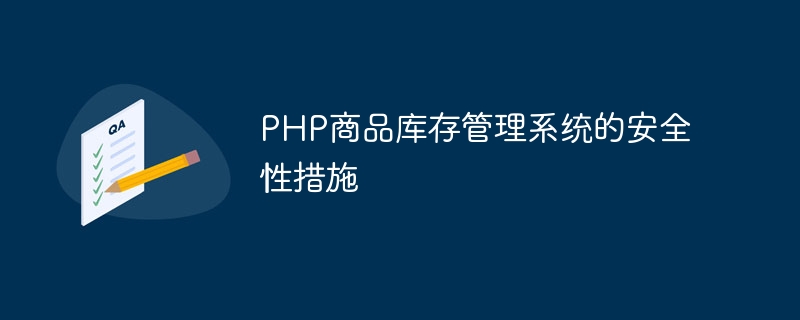Home >Backend Development >PHP Tutorial >Security Measures of PHP Product Inventory Management System
Security Measures of PHP Product Inventory Management System
- PHPzOriginal
- 2023-08-19 08:23:01711browse

Security Measures of PHP Product Inventory Management System
In recent years, with the rapid development of e-commerce, more and more companies choose to sell goods online. However, in the face of a large number of orders and inventory management, how to ensure the security of the system has become an important issue. This article will introduce some security measures commonly used in PHP product inventory management systems and provide some code examples for reference.
- Input data verification
No matter what programming language is used to develop a product inventory management system, input data verification is a crucial part. User-entered data should be strictly verified and filtered to prevent malicious injection attacks and code injection attacks. Common validations include data type validation, length validation, regular expression validation, etc.
The following is a simple example that demonstrates how to verify the quantity of products entered by the user:
<?php
// 获取用户输入的商品数量
$quantity = $_POST['quantity'];
// 判断输入是否为正整数
if(!preg_match('/^[1-9]d*$/', $quantity)){
echo "请输入有效的商品数量";
exit;
}
// 验证通过,继续其他操作- Use secure database operations
In the product In inventory management systems, databases play a very important role. To prevent SQL injection attacks, secure database operation APIs should be used, such as PDO or prepared statements using parameter binding.
The following is an example of using PDO prepared statements to demonstrate how to insert product information into the database:
<?php
// 连接数据库
$db = new PDO('mysql:host=localhost;dbname=my_shop', 'username', 'password');
// 准备SQL语句
$stmt = $db->prepare('INSERT INTO products (name, quantity) VALUES (:name, :quantity)');
// 绑定参数
$stmt->bindParam(':name', $name);
$stmt->bindParam(':quantity', $quantity);
// 设置参数值
$name = 'iPhone';
$quantity = 10;
// 执行SQL语句
$stmt->execute();- Password encryption and user authentication
In the product inventory management system, the administrator account is very important. To ensure the security of administrator accounts, passwords should be encrypted and stored, and a secure authentication mechanism should be used.
The following is an example of using the password_hash() function for password encryption and the password_verify() function to verify the password:
<?php
// 用户注册时,加密并存储密码
$password = $_POST['password'];
$hashed_password = password_hash($password, PASSWORD_DEFAULT);
// 将$hashed_password保存到数据库中
// 用户登录时,验证密码
$password = $_POST['password'];
// 从数据库中获取保存的$hashed_password
if(password_verify($password, $hashed_password)){
echo "登录成功";
} else {
echo "密码错误";
}- Access Control and Permission Management
In order to protect the security of the commodity inventory management system, access control and permission management should be implemented for different users. Only authorized users can perform specific operations.
The following is a simple example that demonstrates how to use user roles and permission control to protect product addition, deletion and modification operations:
<?php
// 用户授权
$role = $_SESSION['role'];
// 检查用户角色是否有权限执行特定操作
if($role == 'admin'){
// 管理员权限,可以进行商品增删改操作
} else {
// 普通用户权限,只能进行商品查询操作
}In summary, the security measures of the product inventory management system are crucial important. System security can be effectively improved through the implementation of input data verification, use of secure database operations, password encryption and user verification, access control and permission management. We hope that the code examples provided in this article will be helpful to developers when building a PHP product inventory management system.
The above is the detailed content of Security Measures of PHP Product Inventory Management System. For more information, please follow other related articles on the PHP Chinese website!

